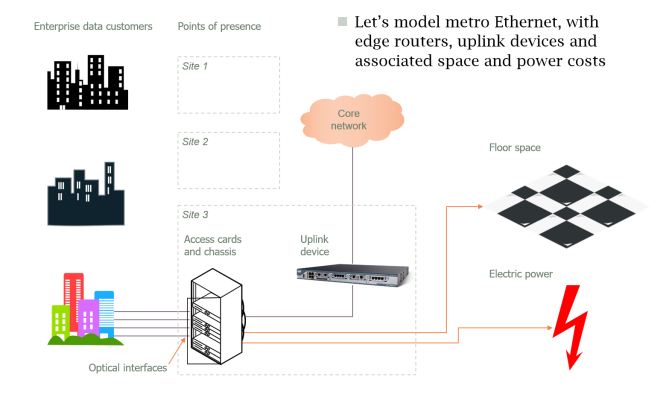Watch the video presentation and/or read the full text below
As a next step up from the wholly generic One-hour tutorial demo, we are going to model the
provision of broadband connectivity in a metropolitan area. This will be a
simplified approach, using just a few key elements as tutorial examples of the
approach that would be used for many more revenue and cost headings in a
detailed, commercial model.

Figure 1: A ‘real life’ modelling context
The area in question has 25 central office locations where
access equipment will be sited, and we will not consider the ring
infrastructure required to connect these buildings. Our focus is the service
and local access provision. We wish to offer a 100 Mbit/s service to a
potential market of 1000 subscribers in the vicinity of these 25 locations. The
business plan will assume a market penetration of 2% by the end of Y1 and 15%
by the end of Y2. We will also assume an optimistic 10:1 contention ratio in
the access equipment, meaning that the subscribers’ traffic will be sporadic
rather than sustained.
The access equipment comprises an access chassis which
accommodates up to 5 access cards, each of which has 16 subscriber-facing
ports. A per-subscriber optical interface (plug-in) is required for each
active port. An uplink device connects the chassis to the assumed ring
infrastructure, and this has a maximum bitrate of 1 Gbit/s.
Each chassis requires 0.5 sq m of floor space in the central
office and has a power consumption of 200W. The corresponding overhead costs
and the costs and physical lifetimes associated with the access equipment are
summarised in the figure below, together with all of the other assumptions.

Figure 2: Some specific assumptions for the model
Note: the otherwise-blank model with notes
of all these assumptions, shown in the video, is available as a free download to the right.
By creating this model, we hope to establish what will be a
reasonable tariff to charge for this service; and then, more specifically, what
tariff would be required to achieve payback after a period of five years, or four
years, or even just three years.
Note: the following exercises assume you
have access to the STEM Model Editor. Please refer to the One-hour tutorial
demo if you are unsure about how to load the software.